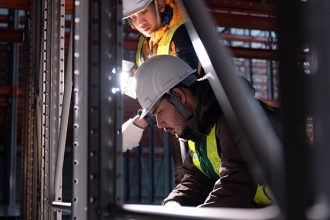Rack Beam Deflection Limits Specify The Maximum Permissible Amount Of Bowing

When a pallet load is placed on the load support beams in industrial steel storage rack, the beams will naturally deflect, or bow, under the load. Because of this, when a qualified rack design engineer determines the requirements for a pallet support beam, the maximum amount of permissible deflection (or bowing) is included in the calculations. As noted in Section 5.3 of RMI’s ANSI MH16.1: Specification for the Design, Testing and Utilization of Industrial Steel Storage Racks, the deflection limit equals the horizontal length of the beam divided by 180 (or 0.55% of the clear distance between the columns).
The beam length divided by 180 (L/180) of the clear span limit is an industry consensus figure, however, not a parameter that ensures the structural integrity of the beam or rack. Instead, the maximum deflection limit assures personnel working around and interacting with the rack that they are safe when observing typical pallet beam deflection. After careful study, RMI members determined that the calculation of L/180 quantified the point at which a person would perceive the deflection of a beam to be unsafe. Tighter tolerances may be required, particularly for beams used in pallet flow rack or pushback rack installations, or requested.
While pallet beam deflection limits do not correspond directly to rack safety, improperly placed pallet loads can cause a safety issue when removing them or the products or cases stacked atop the pallets. Because of the natural beam deflection caused by the weight of the pallets (usually two per bay) the loads will tilt toward each other, getting closer toward the top. If the pallets have been improperly placed in the rack (asymmetrically, unevenly, or with non-uniform weight distribution) there is an increased risk that a pallet load of product will come into contact with another during load placement or removal — and potentially fall or injure a worker — is increased.
Rack installations accessed by automated systems — such as the robotic load or pallet inserters and extractors deployed with automated storage and retrieval systems (AS/RS) — are typically engineered with a tighter deflection limit for load beams, such as the length of the beams divided by 240 (or 0.42%). This lesser degree of permissible deflection reduces the chance of the load or the automated equipment handling it coming into contact with the beams during placement or removal.
Need more details about load beam limits? More information can be found in RMI’s Frequently Asked Questions, load beam section.


